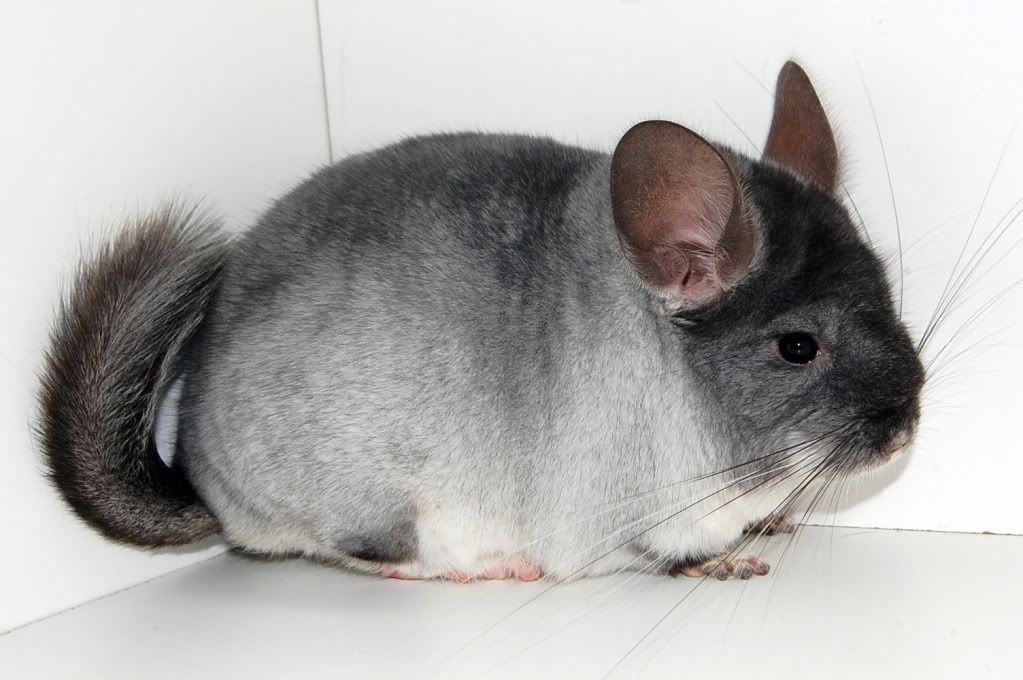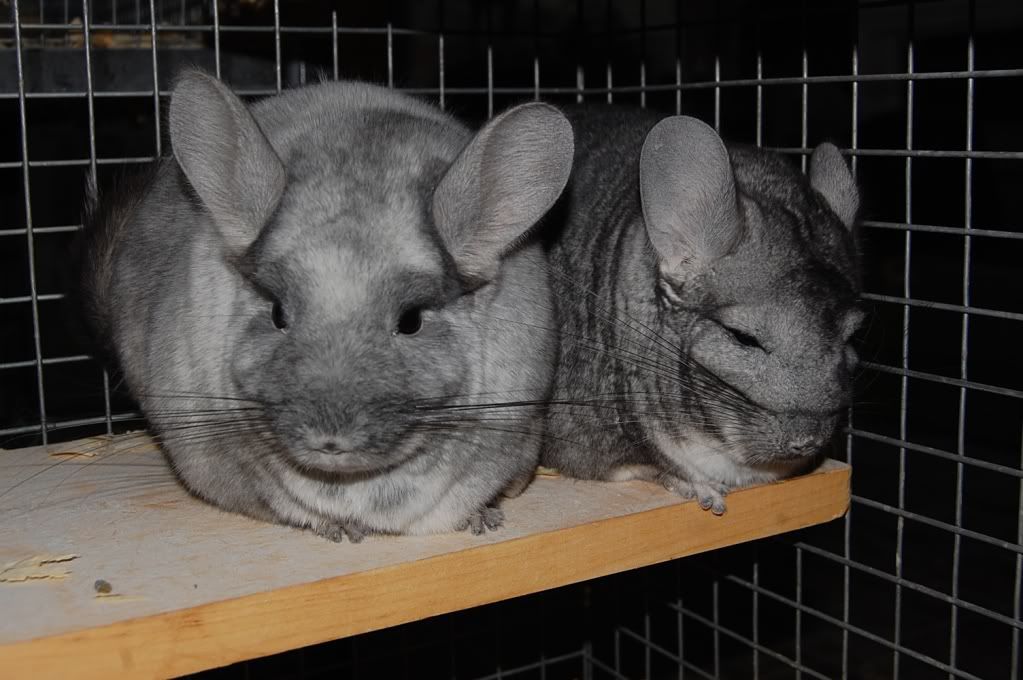Ok. I think I understand the difference between TOV and velvet.... But I just want to make sure. As far as I understand it, a velvet should have a dark (either brown or black) face and back which fades as it goes down. with very white belly. Where as a TOV is darker on top and fades as it reaches the belly but never compete goes white. is that correct? How can you tell if a chin is a TOV or just has a "dirty belly"?how do you know when a white is a TOV? I appreciate your time in explaining this, colors still confuse me.
You are using an out of date browser. It may not display this or other websites correctly.
You should upgrade or use an alternative browser.
You should upgrade or use an alternative browser.
TOV vs. velvet
- Thread starter Narcissus
- Start date

Help Support Chinchilla & Hedgehog Pet Forum:
This site may earn a commission from merchant affiliate
links, including eBay, Amazon, and others.
TOV (touch of velvet) and velvet are the same thing. A TOV/Velvet should have a white belly UNLESS it is a TOV Ebony.
Ebony is what wraps the color around to the belly, and with ebony you do not have a white belly.
As for telling if a White is TOV? Looking at the genetics will give you an idea if it CAN be, and the only way to know for sure is to breed it and have it produce a TOV animal. Whites can look exactly like a tov animal (mask, veiling and paw stripes) but have no TOV in the background. It can be completely white yet be a TOV animal and throw the gene.
Ebony is what wraps the color around to the belly, and with ebony you do not have a white belly.
As for telling if a White is TOV? Looking at the genetics will give you an idea if it CAN be, and the only way to know for sure is to breed it and have it produce a TOV animal. Whites can look exactly like a tov animal (mask, veiling and paw stripes) but have no TOV in the background. It can be completely white yet be a TOV animal and throw the gene.
Silverrose
Chinnie kisses!
TOV and "velvet" mean the same thing. TOV stands for Touch of Velvet. In any case, it creates a darker veiling over the face and back, within any color. In a standard animal, the darker veiling gives it that black color, which we call the Black Velvet mutation. TOV can be found in any other color, such as if a beige is that darker veiling and has the TOV gene, it is called a Brown Velvet. Wraps can also carry the TOV gene, also making their face and back color darker, i.e. TOV tan, ebony, violet, etc. And also so on and so forth with the rest of the color mutations.
ETA: And Megan beat me. hah!
ETA: And Megan beat me. hah!
Last edited:
threewingedfury
<3 BIG and Blocky <3
TOV means "Touch of Velvet" - meaning, there is a black velvet gene in the animal. I believe that it was first used with Brown Velvets (beige x black velvet), which were called TOV Beiges. You cannot have a TOV unless a black velvet is in the lines. A dirty belly has absolutely nothing to do with TOV or black velvet, it just means you have a dirty belly from ebony in the lines, tipping from breeding two very dark animals together, or just poor breeding practices.
You cannot for certain tell if an animal is a TOV unless you breed it and it produces a black velvet. Sometimes the mask and veiling is more prominent in certain animals, and it has thrown me a loop quite a few times, especially in whites.
For instance, I have a white male here out of a proven TOV white and a standard that I believe is a TOV, but can't prove he really is until he produces a black velvet kit. I'm just going by his mask and veiling, but his mother does not have the prominent mask and veiling that shows she's a TOV. Some TOV whites darken with weird spots as they age.

His mother:

You cannot for certain tell if an animal is a TOV unless you breed it and it produces a black velvet. Sometimes the mask and veiling is more prominent in certain animals, and it has thrown me a loop quite a few times, especially in whites.
For instance, I have a white male here out of a proven TOV white and a standard that I believe is a TOV, but can't prove he really is until he produces a black velvet kit. I'm just going by his mask and veiling, but his mother does not have the prominent mask and veiling that shows she's a TOV. Some TOV whites darken with weird spots as they age.

His mother:

Last edited:
You cannot for certain tell if an animal is a TOV unless you breed it and it produces a black velvet. Sometimes the mask and veiling is more prominent in certain animals, and it has thrown me a loop quite a few times, especially in whites.
I just want to add onto this. When we think TOV we normally tend to think "Black Velvet" however if the animal in questions is mated and produces other TOV animals (Brown velvet, for instance) it is still TOV- it doesn't have to produce a black velvet to be a TOV animal. A white would need to produce a TOV animal to be able to know 100% sure that it is a TOV.
Tiff's kit above looks very much like a TOV white, most likely is but like her most of us wouldn't sell it as a TOV White until it produces offspring that display the TOV gene(Black velvet, brown velvet etc)
threewingedfury
<3 BIG and Blocky <3
I just want to add onto this. When we think TOV we normally tend to think "Black Velvet" however if the animal in questions is mated and produces other TOV animals (Brown velvet, for instance) it is still TOV- it doesn't have to produce a black velvet to be a TOV animal. A white would need to produce a TOV animal to be able to know 100% sure that it is a TOV.
Tiff's kit above looks very much like a TOV white, most likely is but like her most of us wouldn't sell it as a TOV White until it produces offspring that display the TOV gene(Black velvet, brown velvet etc)
Correct - meant to say throw a black velvet gene. I think this guy is a TOV white, but don't know for sure, hence why he is being sold as a pet ;-)

$17.99 ($17.99 / Count)
CAKECERY Sonic the Hedgehog II 2022 KL Edible Cake Image Topper Personalized Birthday Cake Banner 1/4 Sheet
CAKECERY

$9.69 ($9.69 / Count)
Squirrel-Cal 3.5 oz. - Ultra-fine Powdered Calcium Supplement - for Pet Squirrels
ZooPro

$17.99 ($17.99 / Count)
CAKECERY Sonic the Hedgehog II 2022 MG Edible Cake Image Topper Personalized Birthday Cake Banner 1/4 Sheet
CAKECERY

$9.22
$15.95
The Hedgehog: An Owner's Guide to a Happy Healthy Pet (Happy Healthy Pet, 163)
Amazon.com

$17.99 ($9.00 / Count)
ZOKU Individual Character Pops, Hedgehog Ice Pop Mold, Easy-Release Silicone Design, Set of 2
ZOKU LLC

$5.48 ($0.31 / Ounce)
Sonic The Hedgehog Fruit Flavored Snacks, Treat Pouches, Gluten Free Snack, Value Pack, 22 Ct, 17.6 oz
Amazon.com

$9.78 ($2.79 / lb)
$10.79 ($3.08 / lb)
Purina ONE Natural, Low Fat, Weight Control, Indoor Dry Cat Food, +Plus Indoor Advantage - 3.5 lb. Bag
Amazon.com

$3.99 ($31.92 / lb)
Wild Harvest Food And Unique Edible Treats for Guinea Pigs, Hamsters, Gerbils, and Adult Rabbits
Amazon.com

$12.99 ($12.99 / Fl Oz)
$14.29 ($14.29 / Fl Oz)
HERCOCCI Guinea Pig Fleece Cage Liners, Super Absorbent – Reusable & Washable Guinea Pig Pee Pads Bedding for Rabbit Chinchilla Hedgehog Gerbil Hamster (2 Pack - 23.6’’ x 17.7’’)
Small Animal - US

$12.29
$12.99
All Things Hedgehogs For Kids: Filled With Plenty of Facts, Photos, and Fun to Learn all About hedgehogs
Amazon.com

$9.99 ($9.99 / Count)
Pill Box 3 Compartment Square Small Pill Case Travel Pillbox for Purse Pocket Blue Chinchillas Metal Medicine Organizer Portable Pill Container Holder to Hold Vitamins Medication Supplements
NatTco-US Specialty Store

$10.99 ($10.99 / Count)
Pill Box 3 Compartment Round Small Pill Case Travel Pillbox for Purse Pocket Blue Chinchillas Metal Medicine Organizer Portable Pill Container Holder to Hold Vitamins Medication Supplements
NatTco-US Specialty Store

$24.48 ($0.24 / Count)
Urinary Support by Sherwood Pet Health (100 Tablets - 60 Grams)
Sherwood Forest Natural Rabbit Foods
That's why I asked. I was totally wrong! But I understand it now.... Thank you. By the way you guys should check out www.chinchillasalaska.com. Who ever write their section on colors was retarded! Even I(confused as I am) know they are completely wrong!
I have contacted those eejits numerous times to tell them how bad their entire website is. They don't care. They have a very small market of very small buyers and they believe everything they tell them - so they don't bother to provide correct information.
starleomach
Dawnna's Keeper
Many many websites out there have no correct information. Sad thing is there is more bad info on the internet than good info























